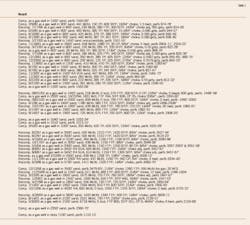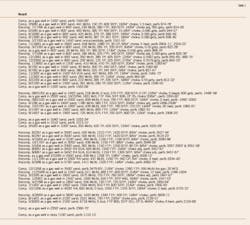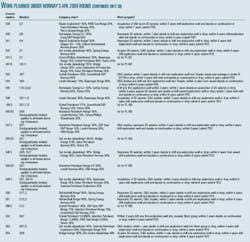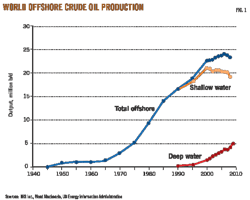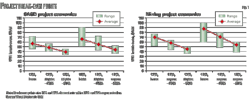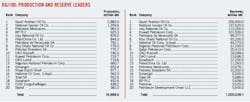Certain classes of diesel fuel are dyed red under regulations of the US Environmental Protection Agency and Internal Revenue Service. The goals of these regulations are to minimize emissions and ensure tax-exempt fuel is not used on public roadways.
This article reports on development of a low-cost, rugged sensor for measuring fuel-dye concentrations that can be mounted on a pipeline sight glass at fuel refineries and terminals.
Studies conducted in this development used three different light-emitting diode/photodiode sensors to measure Solvent Red 26 in kerosine and Solvent Red 164 in diesel at concentrations ranging 0-43 mg/l. The sensors were tested with three different types of sample cells: a flow-through cuvette, 50-ml glass vials, and a 9.5-cm ID glass cylinder with 6 mm WT (to simulate a sight glass on a fuel-transfer pipe).
These are the breadboard sensors for detection of red dye in diesel: High-power LED with separate filtered photodiode detector (A); LED/filtered photodiode in a single integrated component (B); Dual white LEDs with red/green/blue filtered detector array (C; Fig. 1).
Each LED sensor exhibits different dynamic range, linearity, and sensitivity, which can be changed by altering the LED/detector angle. The sensors can readily measure dye concentrations several times lower and higher than the EPA and IRS requirements (2.2 and 11.1 mg/l., respectively).
Regulations
IRS regulations require that tax-exempt fuel contain a level of Solvent Red 164 (SR164) dye that is spectrally equivalent to >11.1 mg/l. of a highly similar Solvent Red 26 dye (SR26) standard, which is available in pure form. SR164 is used to dye fuel because it less expensive than SR26 and has alkyl hydrocarbon chains that improve fuel solubility.
EPA regulations only require a dye concentration that is one fifth as high as the IRS levels. The higher dye concentration required by the IRS readily enables detection of dyed fuel that may have been diluted with undyed fuel.
Solvent Red dyes can be readily measured in fuels with optical spectroscopy,1 in which the use of spectral derivative processing removes the broad absorption band in the 500-600 nm region exhibited by fuels, allowing accurate measurement of the more narrow Solvent Red absorption bands in that region.
The American Society for Testing and Materials International has a published method that uses visible absorption spectroscopy to determine SR164 dye in diesel fuels.2 These methods are highly quantitative and considered "gold-standard" measurement techniques for the determination of Solvent Red in fuel. They also, however, require instrumentation that is not low-cost and significant involvement of an operator for sample measurement and data processing.
The estimated 1,500-2,000 fuel distribution terminals throughout the US3 mix liquid dye concentrates with undyed fuel immediately before delivery to a carrier. To ensure a carrier receives the correct fuel (and pays appropriate taxes), dye dispensing and mixing systems at the distribution terminals employ a number of security measures.
All these security measures, however, involve administrative and engineering controls that limit tampering, etc. A better way to confirm that dye is being or has been added to fuel is simply to perform a direct measurement of the dye in the fuel after mixing.
The goal of the work reported on here was to develop a low-cost, robust sensor to allow direct measurement at refineries and fuel terminals of Solvent Red 164 dye concentration in off-road fuel. Optical absorption sensors based on light-emitting diodes are rugged and low-cost, have low power consumption, and can be designed to be intrinsically safe.4
LED-based systems have been used in a variety of chemical-detection applications including heavy metals, pH, CO2, and O2.5-8
Our approach was to develop a sensor that could be mounted on a pipeline sight glass, precluding the need for direct contact of the sensor with the fuel. This article reports on the design and testing of three different LED/photodiode sensors using reflectance spectrometry for measuring dye concentration.
LED sensor designs
Two sensors were constructed that use a green filtered photodiode light detector and a green LED emitter that overlaps with the primary absorption band for Solvent Red 164 and Solvent Red 26 dye standard. A more sophisticated sensor employed dual white LEDs for sample illumination and an array of filtered photodetectors providing light-absorption data output in three separate wavelength channels (red, green, and blue). Fig. 1 shows photographs and schematics of the sensors.
The larger sensor (A; Kingbright, City of Industry, Calif.) uses an 18,000 millicandela InGaN LED with a 520-nanometer center wavelength, a spectral line half-width of 35 nm, and a 20° viewing angle. The photodetector includes a single component green filtered photodiode detector with integral lens, amplifier, and light-to-voltage converter (from Texas Advanced Optoelectronic Solutions, Plano, Tex.). The filter has a peak transmission at 540 nm with a full-width-half-max (FWHM) of ~80 nm. All additional electronics are on the back side of the circuit board shown in Fig. 1(A).
The sensor shown in Fig. 1b (from TAOS, Plano, Tex.) is based on a single integrated component containing a green LED (567 nm center wavelength, spectral line half-width = 26 nm), filtered photodiode detector (540 nm peak transmission, FWHM = 80 nm), amplification, and light-to-voltage conversion electronics. Although this sensor has a much lower intensity LED, it is significantly smaller, costs less, and requires minimal ancillary electronics.
This 9.5-cm ID glass sampling chamber was used for final sensor testing (Fig. 2).
The sensor shown in Fig. 1 (C; from TAOS, Plano, Tex.) has two white LEDs and an 8 by 8 array of photodiodes: 16 photodiodes have blue filters, 16 photodiodes have green filters, 16 photodiodes have red filters, and 16 photodiodes are clear with no filters. The position of the filters is randomized to provide better averaging of object color.
A voltmeter (from Fluke, Model 187, Everett, Wash.) was used to read the output of the photodiodes for the sensors shown in Figs. 1(A) and 1(B). A vendor supplied-software package recorded the output of the red, green, and blue channels for the sensor shown in Fig. 1(C).
Sample cells
The sensors were tested with Solvent Red 26 in kerosine and Solvent Red 164 in diesel at concentrations ranging 0-43 mg/l. Air samples (no fuel present in sample cell) were also measured.
Three different types of sample cells were tested:
- An optical-quality grade flow-through cuvette.
- 50-ml standard glass vials used for collection of environmental water samples.
- A 9.5-cm ID glass cylinder with 6 mm WT (to simulate a large transfer pipe).
The three sensors were mounted to the flow-through glass cuvette with 1-cm path length for initial testing in kerosine with Solvent Red 26. Only one reading per sample was taken for initial testing.
Five replicate measurements for each sample were made with a 50-ml glass vial sample chamber with 2.5 cm ID and 1.5 mm WT. These tests were performed with Solvent Red 26 in kerosine and Solvent Red 164 in diesel for the three sensors.
Final testing was performed by the sensors being mounted on the outside of a glass cylinder with 9.5-cm ID and 6-mm WT to simulate a large fuel-transfer pipe (Fig. 2). The 6-mm WT was used to simulate more closely the thickness of a sight-glass on a fuel-transfer line that could provide a convenient location for mounting these types of sensors..
Fig. 2 also shows a dip-probe sensor, which is not discussed any further here, and no data are shown. Dyed diesel samples (300 ml) were introduced into the sampling chamber, and data from each of the three sensors were collected sequentially to avoid interference among sensors. Kerosine standards were not measured with this sampling chamber. After measurement, samples were removed with a large-volume pipette, and the chamber rinsed with a small amount of the next sample to reduce carryover. Samples were measured in the order from lowest to highest concentration.
The broad absorption band of the Solvent Red dyes results in light attenuation in both red and blue spectral regions with a smaller amount of attenuation in the red region. For these sensors, the amount of light detected is inversely proportional to the dye concentration in the sample.
A summary of results appears presently.
Sensors are designated as 1A, 1B, and 1C, according to Fig. 1. All data have been converted from raw detector output voltage to absorbance units. Absorbance was calculated with the following relationship:
A = –log10(I/Io)
Where:
A = absorbance
I = sample voltage reading
Io = blank (0 mg/l.) voltage reading
Flow-through chamber
Flowthrough cuvette measurements were only made on Solvent Red 26 standards in kerosine. Only a single sample was measured at each concentration.
As Fig. 3 shows, each sensor has advantages with regards to its sensitivity and dynamic range for this particular sampling or measurement configuration. Sensor 1A has poor discrimination of low dye concentrations but good dynamic range. Sensor 1C has excellent sensitivity but poor dynamic range. Sensor 1B is in between these two extremes.
Fig. 3d illustrates the improvement in measurement uniformity when multiple channels are used to compute a final reading. It is important to note that for Sensor 1A and 1C, the angle of the LEDs relative to the detector can be changed and set as desired.
As the LEDs are angled towards the sensor, the depth of penetration of light into the sample decreases, resulting in improved dynamic range but decreased sensitivity. As the LEDs are angled away from the detector, the light is forced to travel a longer path before reaching the detector (via solution backscatter) resulting in greater sensitivity but decreased dynamic range.
Glass vial chamber
Following successful demonstration of the sensors with a simple flow-through cuvette, each sensor was then mounted in a fixture so that it contacted the outer surface of a 50-ml round glass vial. Dyed kerosine and diesel samples were dispensed and aspirated into the vial for each measurement. Five replicate readings were taken for each sample by aspirating and redispensing the sample into the vial.
The plots in Fig. 4 include error bars, but because standard deviations were generally <1%, the error bars are not apparent. Fig. 4 shows data for sensors 1A and 1B. Sensor 1A yields absorbance values that are about four times higher vs. Sensor 1B. The response of both sensors begins to plateau at dye concentrations greater than about 20 mg/l. Absorbance values for diesel are slightly lower for kerosine for the same sensor, which may result from the slightly greater back-reflectance of light from diesel. When compared with data from the flow-through cuvette, Sensor 1B yields absorbance values about 16 times higher.
These differences are likely primarily due to the greater amount of backscatter from the cell walls in the smaller flow-through cuvette, leading to lower apparent absorption values. Because changes were made to the angle of the LEDs for Sensor 1A, absorbance values for the 50-ml vials (2.5 cm ID) cannot be directly compared with the flow-through cuvette results.
Fig. 5 shows data for Sensor 1C. This sensor requires an initialization at power-up and depending on the background presented to the sensor, each channel (red, green, and blue) is assigned a different gain setting. Initialization was with a 0-mg/l. standard for these measurements.
As Fig. 5 shows, the red channel was saturated at all dye concentrations (i.e., no difference in light intensity vs. blank). As with the flow-through cuvette measurement, this measurement scenario also resulted in the blue channel giving higher absorbance values than the green channel.
Reproducibility was excellent. Absorbance values for this measurement chamber are lower than the flow-through cuvette data but cannot be directly compared because changes were made to the angular position of the LEDs relative to the detectors.
To illustrate the dependence of the LED placement angle relative to the photodiode detector, measurements were taken with the angle between the LED and photodiode for Sensor 1A at ~90° and ~120° (Fig. 6).
At greater angles (i.e., LED directed more towards the detector), the sensor is less sensitive, but the midpoint of the response curve is closer to the 11.1-mg/l. IRS-required dye concentration. This allows more accurate measurement of dye concentrations in the vicinity of 11.1 mg/l. at the expense of being unable to quantify dye concentrations of less than ~1 mg/ml.
9.5-cm ID chamber
A final test for the sensors attempted to simulate measurement in large-diameter fuel transfer pipes and through thick sight glass. Each sensor was mounted on the outer circumference of a 9.5-cm ID glass cylinder with a 6-mm WT. Sensors 1A and 1C were modified by changing the LED/detector angle to produce readings that were near half detector saturation at dye concentrations of 11 mg/l. The diesel sample (300 ml) was added and each sensor sequentially powered up, measured, and then powered down.
Different concentrations of dye were made by a small known volume of 3.4% Solvent Red 164 dissolved in xylene into the cylinder and mixing well before repeating the measurement sequence with all the sensors. Because the volume of dye added was less than 1 ml, the effect of the additional dye volume on the final concentration in the 300-ml sample was negligible (<0.5%).
Fig. 7 shows data for the three sensors.
Sensors 1A and 1C show excellent correlation of light absorbance with dye concentration, with good discrimination of dye concentrations well above and below 11.1 mg/l.
All three channels (red, green, blue) of Sensor 1C showed good correlation of absorbance with dye concentration at all concentrations. Sensor 1B could not discriminate dye concentrations above ~10 mg/l. but had excellent sensitivity at dye concentrations less than ~10 mg/l. The penetration depth of light into the sample for Sensor 1A was likely significantly affected by the thick glass walls of the sampling vessel, as shown by the low absorbance values.
All sensors exhibited significantly lower absorbance values relative to data collected in the smaller sample vessels, which is likely due to the reduction in back-reflection from inner walls of the large sampling chamber.
It should also be noted that all sensors had absorbance readings that were significantly lower in air (vs. 0 mg/l. dye concentration in diesel) that could be exploited to indicate the presence of fuel vs. air in a fuel-transfer pipe.
Results
Sensor designs 1A and 1C show significant promise for use as fuel-dye monitors at refineries and fuel terminals. Other sensor designs (1B) may also have utility for fuel-dye monitoring. These sensors can readily measure the IRS 11.1-mg/l. dye concentration requirement; Sensors 1A and 1C can discriminate concentrations several times lower and higher, depending on LED/detector angle.
The component costs for these sensors range from $1-10, providing an extremely cost-effective means of monitoring fuel-dye concentration. The LEDs have extraordinarily long lifetimes (~10,000 hr), which can be extended by pulsing the LEDs and only powering them during intermittent measurements, since LEDs require no warm-up time.
The sensors can be mounted in explosionproof housings and absorption measurements can be made through thick sight glass. Sensor outputs are easily data-logged and can be linked with other equipment, monitors, and alarms. Multiple sensors of the same or different type can be integrated for redundancy and improved accuracy.
While not explored here, sensors incorporating different wavelength channels (for example, sensor design 1C or variants of it) should allow accurate measurement of fuel-dye concentrations over a range of conditions and sample types by allowing compensation for color, density/refractive index differences, air bubbles, background fluorescence, and particulates.
Acknowledgment
This work was supported by the US Internal Revenue Service through an interagency agreement with the US Department of Energy under Contract DE-AC05-76RLO1830.
References
- Leung, C-P., and Tam, S. Y-K., "Quantitative Determination of Solvent Red 24 in Hydrocarbon Oils by Derivative Spectroscopy," Analyst, Vol. 110 (July 1985), pp. 883-884.
- ASTM Standard D6258-04, "Standard Test Method for Determination of Solvent Red 164 Dye Concentration in Diesel Fuels," ASTM International, West Conshohocken, Pa., www.astm.org.
- Hadder, G.R., and McNutt, B.D., "Ultra-Clean Diesel Fuel: US Production and Distribution Capability," report prepared for Office of Energy Efficiency and Renewable Energy, US Department of Energy, by Oak Ridge National Laboratory, Report No. ORNL/TM-2000/191, August 2000.
- McStay, D., McIlroy, J., Forte, A., Lunney, F., Greenway, T., Thabeth, K., and Dean, G., "A new tool for the rapid remote detection of leaks from subsea pipelines during remotely operated vehicle inspections," J. Opt. A: Pure Appl. Opt., Vol. 7 (2005), S346-S351.
- Lau, K-T., McHugh, E., Baldwin, S., and Diamond, D., "Paired emitter-detector light emitting diodes for the measurement of lead (II) and cadmium (II)," Anal. Chim. Acta., Vol. 569 (2006), pp. 221-226.
- Weigl, B.H., Holobar, A., Trettnak, W., Klimant, I., Kraus, H., O'Leary, P., and Wolfbeis, O.S., "Optical triple sensor for measuring pH, oxygen and carbon dioxide," J. of Biotechn., Vol. 32 (2004), pp. 127-138.
- Grattan, K.T.V., Mouaziz, A., and Palmer, A.W., "Dual Wavelength Optical Fibre Sensor for pH Measurement," Biosensors, Vol. 3 (1987-88), pp. 17-25.
- Lau, K-T., Shepherd, R., and Diamond, D., "Solid State pH Sensor Based on Light Emitting Diodes (LED) As Detector Platform," Sensors, Vol. 6 (2006), pp. 848-859.
R.M. Ozanich Jr. ([email protected]) is currently a senior research scientist in the National Security Directorate at Pacific Northwest National Laboratory operated by Battelle for the US Department of Energy. Before his current position, he was president and founder of Berkeley Instruments Inc. Ozanich holds a PhD (1992) in analytical chemistry from the University of Washington.
A.M. Melville is a scientist with PNNL. She holds a BS (2002) from Washington State University and is a member of the American Chemical Society.
B.W. Wright is a laboratory fellow in the National Security Directorate at PNNL. He holds a PhD (1982) in chemistry from Brigham Young University and is a member of the American Chemical Society and Sigma Xi.
More Oil & Gas Journal Current Issue Articles
More Oil & Gas Journal Archives Issue Articles
